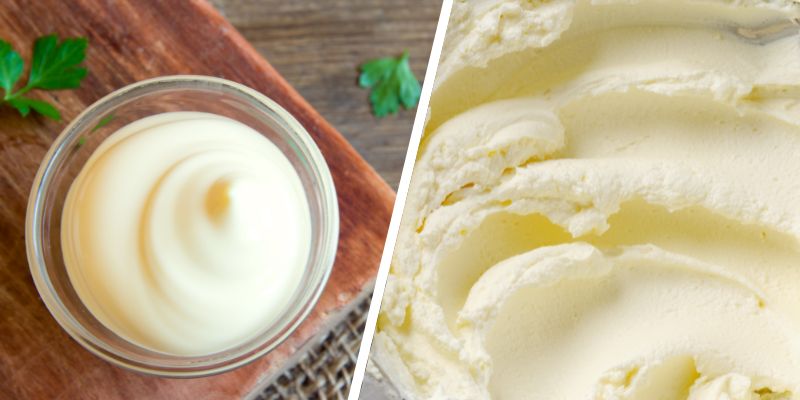If you’re an avid cook or baker, you’ve likely found yourself in a pinch when you’re missing a key ingredient. One such substitution you might have considered is whether you can use mayo instead of cream cheese.
It’s happened to everyone, including me. In this article, I’ll explore this topic in detail and provide you with all the information you need to make an informed decision.
I will also discuss the differences between the two ingredients, as well as when and how you can use mayo instead of cream cheese. Additionally, I’ll provide tips for achieving the best results.
Now, let’s answer the question: Can I use mayo instead of cream cheese?
In my personal experience, I can say that yes, you can use mayo instead of cream cheese in certain recipes. However, it may not work well in others due to differences in flavor and texture. By the end of this article, you’ll have a clear understanding of when and how to use mayo as a substitute for cream cheese in your cooking and baking endeavors.

Mayo vs. Cream Cheese: What’s the Difference?
Before we dive into know the details about can you use mayo instead of cream cheese, it’s important to understand the differences between the two ingredients.
Composition of Mayo
Mayonnaise is typically made from oil, egg yolks, vinegar or lemon juice, and seasonings such as salt and mustard. It has a smooth and creamy texture, but it’s generally thinner than cream cheese.
Composition of Cream Cheese
Cream cheese, on the other hand, is made from a mixture of milk and cream. It has a thick and creamy texture that makes it a popular ingredient in recipes such as cheesecake, frosting, and dips.
Differences in Flavor
The flavors of mayo and cream cheese are distinct from each other. Mayo has a tangy and slightly acidic taste due to the addition of vinegar or lemon juice, while cream cheese has a rich and creamy flavor that’s often described as slightly sweet.
Differences in Texture
In terms of texture, mayo is thinner and smoother than cream cheese, which has a dense and spreadable texture. Additionally, mayo tends to be more fluid and less stable at room temperature, whereas cream cheese is solid and can hold its shape.
Understanding the differences between mayo and cream cheese is important when considering whether they can be used interchangeably in recipes.
In the next section, I’ll explore can you use mayo instead of cream cheese in various cooking and baking applications.
Can I Use Mayo Instead of Cream Cheese?
Now that I’ve explored the differences between mayo and cream cheese, let’s dive into whether mayo can be used as a substitute for cream cheese in various cooking and baking applications.
In Baking
Types of Recipes that Require Cream Cheese in Baking
Cream cheese is a common ingredient in many baking recipes, including cheesecake, frosting, and certain types of cookies.
Substitute Ratio for Baking
When using mayo as a substitute for cream cheese in baking, the general ratio is 1:1. So if a recipe calls for 8 ounces of cream cheese, you can substitute it with 8 ounces of mayo.
Tips for Baking with Mayo
When using mayo as a substitute for cream cheese in baking, there are a few tips to keep in mind. Firstly, since mayo has a different flavor profile than cream cheese, it’s important to adjust other ingredients to ensure the final product has the desired taste. Secondly, mayo has a higher water content than cream cheese, so you may need to adjust the amount of liquid in the recipe.
Finally, since mayo is thinner than cream cheese, you may need to adjust the baking time and temperature accordingly.
In Cooking
Types of Recipes that Require Cream Cheese in Cooking
Cream cheese is also a common ingredient in many savory recipes, such as dips, casseroles, and sauces.
Substitute Ratio for Cooking
When using mayo as a substitute for cream cheese in cooking, the general ratio is 1:1. So if a recipe calls for 4 ounces of cream cheese, you can substitute it with 4 ounces of mayo.
Tips for Cooking with Mayo
When using mayo as a substitute for cream cheese in cooking, there are a few tips to keep in mind. Mayo has a thinner consistency than cream cheese, so you may need to adjust the cooking time and temperature accordingly.
Finally, it’s important to note that mayo has a lower fat content than cream cheese, so it may not work well in recipes that require the creaminess and richness of cream cheese.
In Spreading
Comparison of Mayo and Cream Cheese as Spreads
Both mayo and cream cheese can be used as spreads on bread, bagels, and crackers. However, they have different textures and flavors, which can impact the overall taste and experience.
Pros and Cons of Using Mayo as a Spread
The main advantage of using mayo as a spread is that it has a tangy and slightly acidic taste that pairs well with many foods. Additionally, it’s lower in fat than cream cheese, which can be a healthier option. However, some people may not enjoy the texture or consistency of mayo as a spread, as it’s thinner and less dense than cream cheese.
Tips for Using Mayo as a Spread
When using mayo as a spread, it’s important to keep in mind its thinner consistency. To avoid the mayo from dripping off your bread or bagel, you can mix it with other ingredients such as mustard or cheese to thicken it up.
Additionally, you can experiment with different spices and seasonings to enhance the flavor of the mayo.
Is Mayo Better Than Cream Cheese?
It depends on personal taste and the intended use. Mayo and cream cheese have different flavors and textures, so it’s difficult to say that one is inherently better than the other.
However, if you prefer the tangy, slightly sweet flavor and creamy texture of mayo, then it may be a good substitute for cream cheese in certain recipes or applications.
Some Other substitute for Cream Cheese
If you don’t have cream cheese on hand or you’re looking for a substitute, there are several options that you can use in its place. Here are some alternatives to cream cheese:
- Mascarpone cheese: This Italian cream cheese is richer and smoother than traditional cream cheese and is commonly used in desserts.
- Greek yogurt: Thick and creamy Greek yogurt can be used as a substitute for cream cheese in dips, spreads, and baked goods.
- Cottage cheese: This cheese is lower in fat and calories than cream cheese and can be used in dips, spreads, and desserts.
- Ricotta cheese: This cheese is milder than cream cheese and has a slightly grainy texture. It can be used in desserts, dips, and spreads.
- Tofu: Silken tofu can be blended until smooth and used as a substitute for cream cheese in dips, sauces, and desserts.
- Neufchâtel cheese: This cheese is similar to cream cheese but has a slightly lower fat content and a slightly tangier flavor.
When using these substitutes, keep in mind that the flavor and texture may be slightly different than using cream cheese. It’s always a good idea to experiment with small amounts first before making larger substitutions in a recipe.
Can I Use Homemade Mayo Instead of Cream Cheese?
While homemade mayonnaise can be used as a substitute for cream cheese in some recipes, it’s important to keep in mind that they have different textures and flavor profiles, so the final result may not be exactly the same as using cream cheese.
Mayonnaise is a tangy and creamy sauce made from oil, egg yolks, vinegar or lemon juice, and seasonings. It has a thinner consistency and a tangier flavor than cream cheese. On the other hand, cream cheese is a soft and smooth cheese with a slightly tangy and slightly sweet flavor.
In some recipes, such as dips and spreads, you may be able to use homemade mayo as a substitute for cream cheese. However, in recipes that require cream cheese for its texture, such as cheesecakes or frosting, using mayo instead of cream cheese may not work as well. It’s always best to experiment with small amounts and adjust the recipe as needed when substituting ingredients.
Before You Go
If you’re curious about experimenting with mayo as a substitute for cream cheese in your cooking and baking, why not try it out in your next recipe?
Here is another article you need to know Can Maida Be Used Instead Of Corn Flour?

Leave a Reply